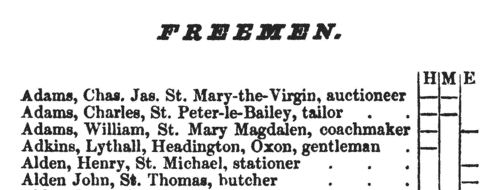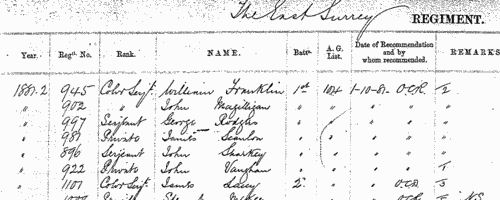Piesley Surname Ancestry ResultsOur indexes 1800-1900 include entries for the spelling 'piesley'. In the period you have requested, we have the following 8 records (displaying 1 to 8): Buy all | | | Get all 8 records to view, to save and print for £46.00 |
These sample scans are from the original record. You will get scans of the full pages or articles where the surname you searched for has been found. Your web browser may prevent the sample windows from opening; in this case please change your browser settings to allow pop-up windows from this site. Berkshire Freeholders: Appleton and Eaton
(1812)
The poll of the freeholders of Berkshire on an election of two representatives in Parliament, taken at Abingdon on Monday 12 October 1812 and fourteen following days. The candidates were Charles Dundas esquire (D: 1717 votes), the Hon. Richard Neville (N: 1374), and William Hallett esquire (H: 525). This poll book sets out the names of the voters in alphabetical order parish by parish. After the name of the parish or township, the name of the hundred in which it lay is given in italics. The freeholders' full names are stated, surname first, and the place of their abode (often elsewhere). The right hand column records their votes. The qualification for suffrage in the counties was the possession of a freehold estate worth more than 40s a year.PIESLEY. Cost: £6.00.  | Sample scan, click to enlarge

| Insolvents
(1827)
Insolvency notices for England and Wales: insolvency often caused people to restart their lives elsewhere, so these are an important source for lost linksPIESLEY. Cost: £6.00.  | Sample scan, click to enlarge

| Freemen of the City of Oxford
(1834)
A List of the Freemen and Householders of the City of Oxford, Registered July 31st, 1834, as Entitled to Vote in the Election of Members for the said City. This starts with an alphabetical list of the freemen of the city, which gives (as in the sample scan) full name, address and occupation. Then follow lists of householders, by parish or ward, but without giving occupations.PIESLEY. Cost: £4.00.  | Sample scan, click to enlarge

| Oxford Householders: St Ebbe's
(1834)
A List of the Freemen and Householders of the City of Oxford, Registered July 31st, 1834, as Entitled to Vote in the Election of Members for the said City. This starts with an alphabetical list of the freemen of the city, which gives (as in the sample scan) full name, address and occupation. Then follow lists of householders, by parish or ward, but without giving occupations.PIESLEY. Cost: £4.00.  | Sample scan, click to enlarge

| Non-Freemen Voters in Oxford: St Ebbe
(1837)
A poll of the freemen and non-freemen electors of the City of Oxford took place on 25 July 1837, the candidates being William Hughes Hughes (H), Donald Maclean (M) and William Erle (E). This poll book lists all 2145 voters, as well as those electors who did not vote. In both cases, the lists are divided into a single register of freemen, and then the non-freemen arranged by parish or ward - All Saints, Cowley, Holywell, St Aldate, St Clement, St Ebbe, St Giles, St John, St Martin, St Mary Magdalen, St Mary the Virgin, St Michael, St Peter in the East, St Peter le Bailey, and St Thomas. The votes of those who voted are shown on the right hand side of the page. The names of the freemen are given with address and occupation; those of non-freemen with address, but without stating occupation.PIESLEY. Cost: £4.00.  | Sample scan, click to enlarge

| Householders of the parish of St Ebbe's in the city of Oxford
(1841)
A parliamentary poll of the freemen and electors of the City of Oxford was taken 30 June 1841, the candidates being Donald Maclean (Mac), James Haughton Langston (Lan) and Neill Malcolm (Mal). The poll book records the names, addresses and occupations of the householders, district by district, as well as the names of the freemen of the city, and shows for whom they voted.PIESLEY. Cost: £6.00.  | Sample scan, click to enlarge

|  Persons of standing recommending London police recruits
(1830-1842) Persons of standing recommending London police recruits
(1830-1842)
The Metropolitan Police Register of Joiners (MEPO 333/4) lists policemen joining the force through to 31 December 1842 (to warrant number 19892). The register is alphabetical, in so far as the recruits are listed chronologically grouped under first letter of surname. It is evidently a continuation of a similar earlier register, not closed until its alphabetical sections were filled: consequently, there are no entries in this register for the initial letters N, O, Q, U, V, X, Y or Z; and the sections of this register start at different dates - A 18 April 1840 (warrant number 16894); B 11 December 1830 (5570); C 7 September 1830 (4988); D 27 May 1833 (8445); E 15 December 1838 (14476); F 30 March 1832 (7372); G 1 December 1835 (11,184); H 25 April 1832 (7457); I and J 13 February 1837 (12449); K 2 January 1838 (13457); L 3 October 1834 (9905); M 15 November 1832 (7999); P 4 October 1831 (6869); R 4 September 1837 (13021); S 30 March 1835 (10366); T 6 April 1840 (16829); W 30 December 1833 (9096). The register gives Date of Appointment, Name, Number of Warrant, Cause of Removal from Force (resigned, dismissed, promoted or died), and Date of Removal. Those recruits not formerly in the police, the army, or some government department, were required to provide (normally) at least two letters of recommendation from persons of standing, and details of these are entered on the facing pages: the names in these are indexed here (the police recruits are indexed separately and not included here). Recruits transferred from other forces or rejoining the force did not normally need recommendations - in the latter case, former warrant numbers are given - but some recommendations are from police inspectors, even other constables. Recruits coming from the army sometimes have general military certificates of good conduct, but most often have a letter from their former commanding officer; recruits recommended by government departments (most often the Home Office) similarly have letters from the head of department. But the great majority of the names and addresses in these pages are of respectable citizens having some sort of personal acquaintance with the recruit. Where more than two recommendations were provided, the clerk would only record one or two, with the words 'and others'. Tradesmen are sometimes identified as such by their occupations; there are some gentry. Although the great bulk of these names are from London and the home counties, a scattering are from further afield throughout Britain and Ireland. PIESLEY. Cost: £8.00.  | Sample scan, click to enlarge

|  Outstanding soldiers of the Royal West Surrey Regiment
(1881-1901) Outstanding soldiers of the Royal West Surrey Regiment
(1881-1901)
Each year the best soldiers of the regiment were chosen for long service and good conduct medals. This register gives rank, name, regimental number, and date of recommendation. (The sample scan is from the East Surrey regiment). The register is essentially a register of recommendations, annotated with details of the issue of the medals. Where no gratuity accompanied the medal, the entry is marked 'W. G.' (without gratuity); where, for one reason or another, the medal was not issued, the entry is marked 'N. S.' (not sanctioned) and struck through. The regiment was based on the 2nd Regimental District - Guildford. The 1st battalion returned from Bombay in 1879, and by 1885 was established at Tralee. It embarked for Malta 24 December 1891, and moved on to India, where it was stationed at Umballa in Bengal by 1895. The 2nd battalion embarked for Malta 26 July 1877, going on to India in 1878, and in 1885 was at Cawnpore. The battalion was moved into Upper Burmah in 1886 ("Burma, 1885-1887" and "Tirah"), back to India in 1888, returning to England in 1894. In 1899 the 2nd battalion was sent to South Africa, adding "South Africa, 1899-1902" and "Relief of Ladysmith" to the colours.PIESLEY. Cost: £8.00.  | Sample scan, click to enlarge

|
Research your ancestry, family history, genealogy and one-name study by direct access to original records and archives indexed by surname.
|











